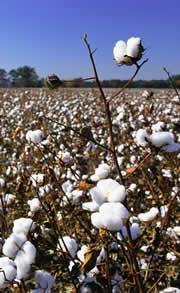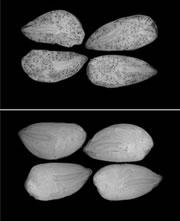 Field of dreams? Engineered cotton could make clothes and food at the same time.Punchstock
Field of dreams? Engineered cotton could make clothes and food at the same time.PunchstockResearchers have genetically engineered cotton plants that produce toxin-free seeds, potentially unlocking enough nutritional content to feed half a billion people worldwide each year.
Cotton is grown in more than 80 countries and is a primary source of fibre for textiles, providing an important cash crop to some 20 million farmers in Asia and Africa. But a little-known characteristic of the cotton plant is that for every kilogram of fibre that is produced, it also yields 1.65 kilograms of seed packed with high-quality protein. So cotton plants have the ability to meet the protein requirements of millions with no reduction to the output of cotton fibres.
Cottonseed is underutilized due to the presence of gossypol, a toxic molecule belonging to a class of organic chemicals known as terpenoids. Gossypol is found in glands throughout the leaves, stems and floral tissues of cotton plants and lends crops protection from insects and pathogens. Only ruminant animals such as cattle can safely digest the toxin.
Now, using RNA interference (RNAi) technology, researchers have managed to disrupt a key enzyme and cut the gossypol content in cottonseeds by 98%, while leaving the chemical defences of the rest of the plant intact. The team shows that the absence of the toxin is heritable and that plants lacking gossypol could be suitable for large-scale agricultural use. The results are reported this week in the Proceedings of the National Academies of Science1.
Food for all
 Normal (top) and engineered toxin-free (bottom) cottonseeds.PNAS
Normal (top) and engineered toxin-free (bottom) cottonseeds.PNAS"What the research does is open up that vast amount of underutilized resource for either direct use as human food or indirect use by making this cottonseed non-toxic to say, chickens, pigs or fish," says Keerti Rathore of the Institute for Plant Genomics and Biotechnology at Texas A&M University in College Station, and the paper's lead author.
Rathore notes that feed goes much further in chickens, pigs and fish than in cows: it takes about 6 kilograms of animal feed to produce one kilogram of beef, whereas the ratio for chicken is closer to two to one.
Deborah Delmer, associate director of the Rockefeller Foundation in New York City and an expert in agricultural food safety, points out that a benefit of using RNAi technology is that it turns off a gene process rather than switching on a novel function. "So instead of introducing a new foreign protein, you're just shutting down one process," Delmer says. "In that sense, I think that the safety concerns should be far less than other GM technologies."
Delmer noted that one yet-unknown aspect of the research is how stable the suppression will be over many generations. The team plans to conduct extensive field trials to find out.
Dry roasted or ready salted?
Researchers first attempted to unlock the nutritional content of cottonseed more than 50 years ago. By breeding a glandless mutant cotton plant, they were able to successfully eliminate the presence of gossypol throughout all tissues of the plant. But the plants quickly fell prey to disease and were unsuitable for farming.
Rathore thinks that RNAi opens great promise for other crops that also contain harmful compounds. A hardy legume plant called grasspea (Lathyrus sativus), for example, could also provide a huge source of nutrition from seeds if it were not for the presence of a neurotoxin. Many poor people in Asia and parts of Africa already resort to eating this so-called famine crop, and sometimes suffer from paralysis and other health problems as a consequence.
ADVERTISEMENT
Cottonseeds have a nutty flavour, says Rathore. The gossypol-free seeds could be roasted and salted, he says, much like soybeans. The meal could also be mixed with flour from wheat, corn, millet or sorghum to provide a protein source in bread.
The authors, who declare no financial interests in the cotton industry, are hopeful that the crop will catch on, despite current social resistance to genetically modified crops. "Not right away, but at least 10 or 20 years down the line, I think people will accept it," Rathore says.
Visit our cottoncouldfeedth.html">newsblog to read and post comments about this story.
-
References
- SunilkumarG., et al. PNAS, 103 . 18054 - 18059 (2006).
